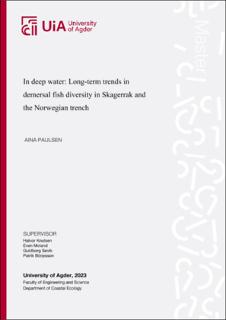| dc.description.abstract | Throughout history, human activities have had profound impacts on marine ecosystems, with clear evidence of these consequences observable in the Skagerrak region. Oceans have historically been a critical resource for humankind, supplying food for the world's population. However, unsustainable practices such as overfishing and the emission of CO2, which leads to increased sea temperatures, have jeopardized this valuable resource.
The current study investigates changes in biodiversity and population size of various fish species in deep water areas of Skagerrak. The data is obtained from the Norwegian Bottom Trawl Survey for Northern Shrimp (Pandalus borealis) in Skagerrak and the Norwegian Deep. Initiated in 1984, this annual survey is conducted by the Norwegian Institute of Marine Research (IMR).
The Shannon index generally revealed large fluctuations in the three shallowest depth strata, down to 400 meters, without a clear trend. Only depth stratum 400-500 meters showed a significant decrease in biodiversity over time (2006-2022). Beyond this depth (500-600m), a weak, non-significant positive trend was noted. Both Norway pout and blue whiting may have influenced the Shannon index values within the 400-500m stratum. Moreover, Norway pout has had an impact on the Shannon index values in other depth strata, except for the 500-600 meters range.
Throughout all depth strata, diversity (H) remains generally low due to the dominance of Norway pout in large areas. At depths of 500-600 meters, roundnose grenadiers have more impact in the H-value, contributing to low diversity in 2008. Recent expansion of bottom trawling at greater depths is discussed as a possible reason for the putative changes in biodiversity in depth strata 400-500 meters. Population assessments conducted earlier suggest that the most significant declines occurred prior to 2006, leading to an assumption of relatively minor changes in many species’ populations from 2006 to 2022. Bottom temperature measurements taken during this period showed no substantial changes that might have significantly influenced the deep-water fish species communities. | |
